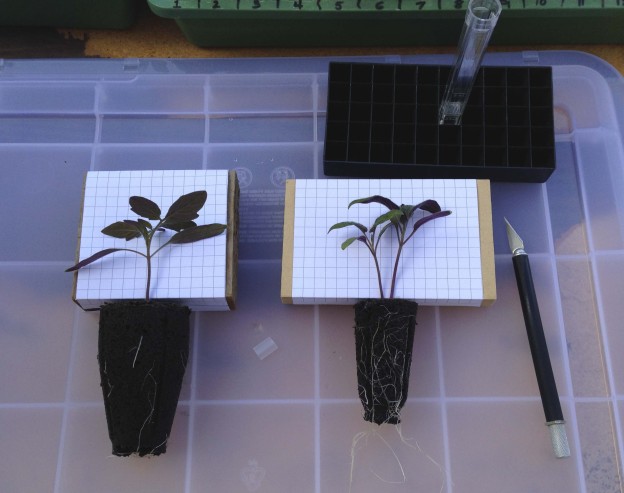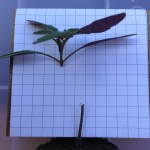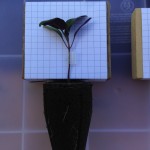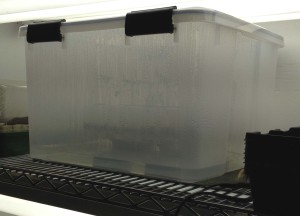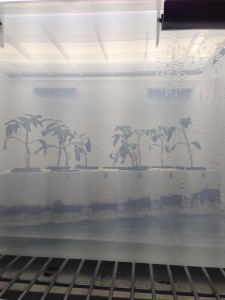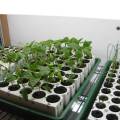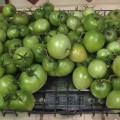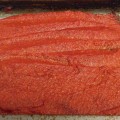Last year I trialed several grafted tomato varieties next to their non-grafted plants. The grafted plants were definitely the winner, as they didn’t show any symptoms of any of the wilts (fusarium, verticillium, bacterial) that hit the non-grafted tomatoes. They also didn’t get hit with Curly Top Virus, although their neighbors did. The production was greater, but without the disease pressure on the non-grafted plants, I can’t say whether the production would have been a difference.
So this year I went looking for more varieties of grafted tomatoes, and found that I could buy my own rootstock and graft my own. Since tomatoes are so easy to propagate by cuttings, I thought that, even though I’m a newbie at this, I would likely have a good enough success rate for this year’s tomato patch. I’m going to be using the Tube Method, and here’s How:
Materials:
- rootstock seed: I’m using Supernatural® Tomato from Territorial Seed
- scion seed: see below for the varieties that I’m going to graft, along with their results
- seed-starting materials: I’ve been using Park Seed’s Bio Dome for the last 10 years because it’s been the most reliable, failure-proof method I’ve tried
- X-acto knife, scalpel or razor blade (old-fashioned kind is best: thinner, more flexible & sharper)
- silicon tube clips (come in different sizes: I’m using 1.5mm)
- spray bottle for water
- spray bottle for rubbing alcohol
- tube to hold rubbing alcohol for holding scalpel or X-acto knife
- healing chamber: large clear plastic tote with a fairly tight-fitting (and clear) lid to keep humidity at 100% and let light in (I found this one at Amazon)
Method:
- Grow your rootstock & scions
- Sow seeds for both rootstock & scions at the same time and using the same conditions. We are aiming for them to both grow at the same rate.
- once both the rootstock and the scions are at two- or three-true-leaf stage, and the diameter of the hypocotyls, our grafting sites, are 1.5mm, it is time to graft. This is about 21 days after seeding for the varieties I grew.
- Graft the Tomatoes:
- choose a rootstock and a scion that have the same size hypocotyls and lay them on their sides on your work space
-
cut the rootstock just below the cotyledons (seed leaves) at a 45 degree angle then place the tube clip
- choose between grafting the scion above or below the cotyledons (at this time I do not know the benefits of either, but I’m going below the cotyledons for my first trial)
- Below: cut 1cm below the cotyledons to leave room for the stem to fit into the tube
- Above: cut just above the cotyledons
- cut the scion to match the same angle as the rootstock was cut (45 degrees)
-
insert the scion into the tube and align the rootstock and the scion together, making sure the cut surfaces are in good contact, and that the clip is securely holding them together
- put the plug back into its tray
- mist with water to cover all of the leaf surfaces to keep the scion happy until it can start pulling water from the rootstock, but don’t saturate the growing medium, which could allow the rootstock to pull up a bunch of water. If this happens, a thin film of water may be created at the grafted union, preventing the scion from connecting well to the rootstock.
- Heal the Grafted Unions:
-
put the tray into the healing chamber (I used blocks to keep the styrofoam above water, so they wouldn’t get saturated, then periodically checked moisture in the growing medium to see when I needed to let the foam float in the water)
- pour water in the bottom of the chamber (about 1/2″ to 1″) to keep humidity at 100% inside
- put the chamber in a warm area. The ideal ambient temp is 80-81°F, which will make the inside of the chamber 84°(which generally gets 3-4 deg warmer than ambient) I used a seedling heat mat to keep it warm, but I did not monitor temps.
- Days 1-2: for the first 24-48 hours keep the chamber in complete darkness (I think the longer time worked better for me here)
-
Days 2-4: put under 2-fixture 4′ fluorescent lamp per 2’x4′ area (note: at some time during this phase, one of the scions popped right off of the rootstock and out of the tube. I found it floating in the water. This has happened to one of my grafts each time I have grafted. The last time it happened, I had room to recut the scion, so I recut & inserted it back into the tube. So far it’s looking good.)
- Day 5: crack the lid of the healing chamber open to start gradually reducing the humidity; if there’s any wilting, then put the lid back on to recover, then start gradually reducing humidity again
- Day 6: move the lid to create about 1/2″ opening
- Day 7-8 remove the lid completely
-
- Pinching: once the grafts have healed, and the plant is not on life-support, you can start encouraging the growth that you want in the seedling
- above the cotyledons: two shoots will come out from the axillary buds
- above the second true leaf: two shoots will come out from each of the true leave’s axillary buds
- Plant the Grafted Tomatoes:
- After the frost danger has passed, the grafted tomatoes can be planted out after hardening them off
- the only thing unique to planting grafted tomatoes, rather than non-grafted ones, is that the graft union must stay above the soil line. We do not want anything above the graft to touch the soil because it will throw down roots, completely defeating the purpose of the graft
- Refer to this article for more about hardening off and planting tomatoes
Results:
2014:
- started both scions & rootstock at same time; this resulted in not much variety in stem widths, for matching scion to rootstock
- used medium-sized seed sponges for the scions & large-sized seed sponges for the rootstock
- grafted 1st wave 22 days after germination = 9 out of 11 grafts successful
- grafted 2nd wave 32 days after germination – none of these did well;
- I think the scion to rootstock stems weren’t a good size match
- the temperature in the healing chamber could have been a factor, since we were really warming up in Redding, and I didn’t monitor the temps inside
- final success rate: 11 out 17 (65%)
- overall conditions for grafting success:
- timing the grafting right
- matching up the stem sizes well
- temperature control in healing chamber
2015:
- started both seeds at the same time again
- grafted 26 days after germination, although they were ready earlier (had to postpone grafting due to travel)
- 27 out of 51 (53%) grafts successful
- same overall conditions for success as last year
- in the garden, all of my non-grafted varieties (except for one hybrid: BurgerMaster) died from wilt, so it’s safe to say the grafted varieties produced more tomatoes than non-grafted 🙂
2016:
- started rootstock in two waves, 5 days apart:
- 1st wave: started 2/25
- 6 Estamino: germinated 3/4
- 12 SuperNatural: germinated 3/2
- 2nd wave: started 3/1
- 18 SuperNatural: germinated 3/7
- 1st wave: started 2/25
- started scions on 2/25 (same day as 1st wave)
- started both scions & rootstock in large-size seed sponges (thinking size of the seed sponge might affect stem width or growth rate, resulting in stem size mismatch)

